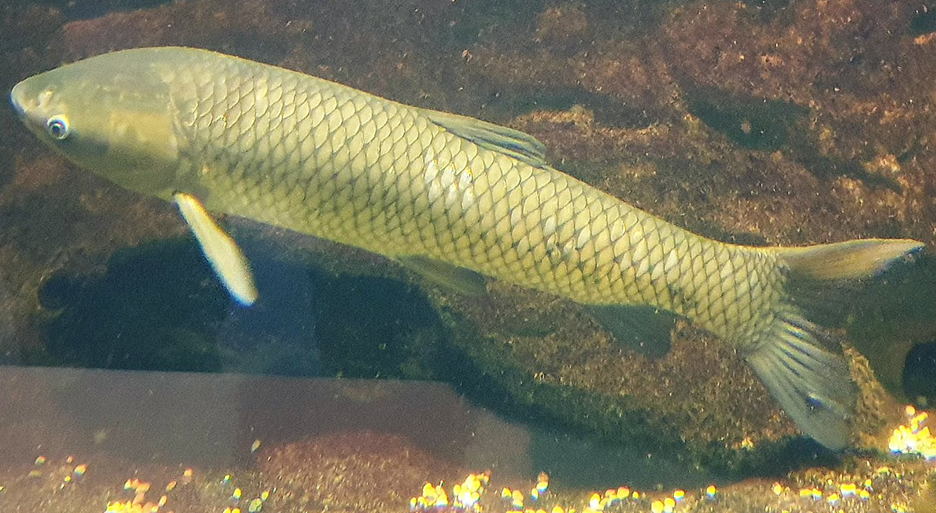Ken Baker: Experts studying ways to keep Grass Carp from overrunning Sandusky River
Maybe it didn’t catch your eye, but a couple of weeks ago, newspapers across Northwest Ohio reported on a significant meeting at Terra State Community College in Fremont.
The Nov. 13 meet-up was a public information session conducted by representatives of the Great Lakes Fishery Commission, the U.S. Army Corps of Engineers, and the ODNR Division of Wildlife.
The groups wanted to discuss why they thought it’d be a good idea to spend a bit under a million of our tax dollars to see how a fish called the Grass Carp might respond to the installation of underwater bubble and sound-generating machines in the Sandusky River at the northern end of Fremont, just a bit downstream from Bradys Island.

Now that seems a curious thing to do. What was their argument?
Million-dollar investment could save Western Lake Erie
The short answer is that it’s a necessary investment to protect the biotic health of Western Lake Erie, the Sandusky and Maumee Rivers … and the economic well-being of all those whose livelihoods depend on the vitality of those water bodies.
If you’re interested in a bit longer but quite readable overview of the who, what and why of what’s being called the Sandusky River Grass Carp Barrier Project, I highly recommend the Corps of Engineers’ recently released 18-page Scoping Information report: usace.contentdm.oclc.org/utils/getfile/collection/p16021coll7/id/24916.
But here’s my nickel’s-worth summary: Grass carp are one of four invasive species of fish that are commonly known as “Asian Carp” in the U.S. Like the Silver, Bighead and Black Carp, it had been intentionally introduced into aquaculture operations in efforts to control unwanted organisms —the Silver and Bighead to control excess plankton clouding pond water, the Black to control mollusks, and the Grass to control aquatic vegetation.
In fairly short order, each species escaped into the wild and has since caused various levels of havoc in much of the nation’s waterways. The Grass Carp (Ctenopharyngodon idella), for example, was originally introduced into fish farming ponds in Arkansas and Alabama in 1963, and is now found in 45 states. It was first reported in Lake Erie in the 1980s, with evidence of successful reproduction in downstream portions of the Sandusky River in 2012.
Grass Carp spawn in rivers with a strong current
One of the Grass Carp’s idiosyncrasies is that while adults, which regularly reach 2-3 feet in length, prefer large, slow moving bodies of water, they need to spawn in rivers with a fairly strong current. That’s because their semi-buoyant fertilized eggs need to be suspended in flowing water above the river bottom during development.
A 2013 study found that within the Great Lakes Basin, the Maumee and Sandusky Rivers of Lake Erie, and the St. Joseph and Milwaukee Rivers of Lake Michigan have the best conditions for successful Grass Carp spawning. And recent research suggests the area of the Sandusky from above Bradys Island to the site of the former Ballville Dam should fit the species’ spawning needs especially well.
While Ohio, like many other states (but not Michigan) still permits the sale of triploid (sterile) Grass Carp for biological control of aquatic plants, data suggest that about 80% of those inhabiting Lake Erie are fertile diploids, and the Sandusky is a major spawning site for them.
Study to determine if bubbles, sound could curb migration
Still, it doesn’t appear the river’s breeding population has attained a large size yet, which is why biologists have decided to conduct this feasibility study to see if they can block the Grass Carp from reaching their spawning grounds in late May/early June. Preliminary studies suggest that creating an underwater curtain of bubbles and/or a band of high-frequency sound stretching across the river has the potential for blocking their upstream migration.

Creating and maintaining an effective barrier won’t come cheaply, however, and it won’t be perfect. At the November meeting, program managers said they’re hoping for a 75% reduction in Grass Carp reaching the spawning area. At the same time, they also don’t want the barrier to interfere with the upstream migration of native species.
Tricky.
But I think they’re right; all this effort and expense will prove worthwhile in the long run. Although Grass Carp do eat invertebrates and small fish as opportunity allows, they are primarily herbivores consuming 25-100% of their body weight (depending on size and environmental conditions) in aquatic vegetation each day.
A large population could quickly decimate the vegetation other fish species use for food, shelter and spawning. And since they only digest about half of what they eat, their nutrient-rich excretions have the potential to enhance algal blooms.
It’s not just the Sandusky that’s worrying these agencies. Western Lake Erie is home to one of the most lucrative recreational fisheries in the nation. In areas where its shallow waters allow light to reach the bottom, abundant growth of aquatic plants provides food and sheltered nurseries for economically important fish and their prey.
What might happen to this productive ecosystem if its Grass Carp population were to suddenly explode, is one of many things that keeps fisheries managers up at night.
Ken Baker is a retired professor of biology and environmental studies from Heidelberg University. If you have a natural history topic you would like Dr. Baker to consider for an upcoming column, please email your idea to fre-newsdesk@gannett.com.
This article originally appeared on Fremont News-Messenger: Sound-generating machines, bubbles among efforts to control Grass Carp

